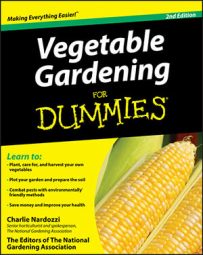Tomatoes require a long growing season, so your best bets are to buy plants or start seeds indoors 4 to 6 weeks before your last frost date. Either way, you want a stocky, 6- to 10-inch tall transplant ready to go into the garden after all danger of frost has passed.
To jump-start tomatoes, preheat the garden soil by laying a plastic sheet over the garden bed, pull it tight, cover the edges with soil, and let the plastic heat the soil for 2 weeks before transplanting.
Planting, trellising, and pruning tomatoes
To get the best tomatoes, you need to plant properly, keep the fruits off the ground, and prune them.
Here are the basic steps for planting tomato plants:
Dig a hole twice the diameter and depth of the tomato root ball.
Place a small handful of all-purpose organic fertilizer or compost into the hole.
Plant the tomato transplant up to its two top-most set of leaves.
Roots will form along the buried stem.
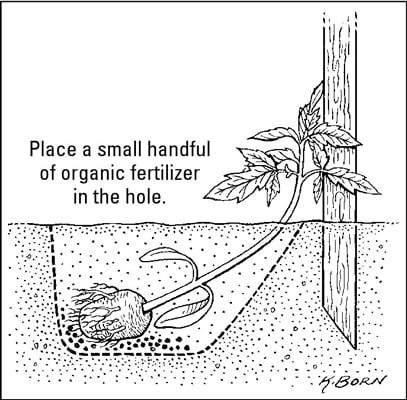 Bury the stem vertically or horizontally in the ground, leaving at least two sets of leaves poking out.
Bury the stem vertically or horizontally in the ground, leaving at least two sets of leaves poking out.
So soon after you transplant, you have to decide which trellising method to use:
Staking: Drive a wooden or metal stake into the ground next to the tomato transplant. Fasten the main trunk of the tomato to the stake with plastic ties.
Caging: Insert a three-ringed metal cage into the soil around your tomato transplant. Keep branches inside the cage as the plant grows.
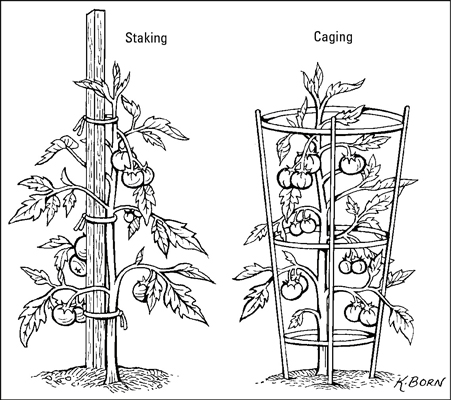 Stake or cage your tomatoes.
Stake or cage your tomatoes.
To keep tomato plants vigorous, remove extra side branches. When these suckers are 3 to 4 inches long, remove them by pinching them out or by cutting them back to the main stem with scissors.
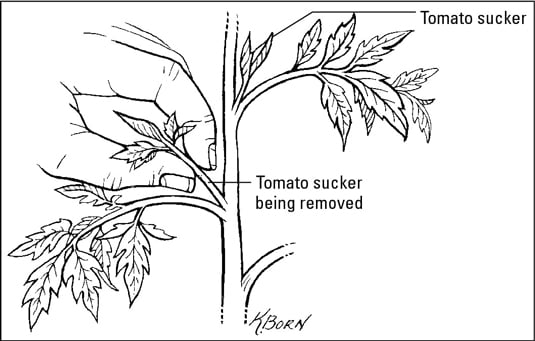
Fertilizing and watering your tomatoes
Side-dress your tomato plants with a complete organic fertilizer, such as 5-5-5. Apply the first side-dressing when the tomatoes are golf-ball sized, and then side-dress every three weeks.
Use fertilizers with lower rates of nitrogen; higher rates cause tomato plants to sport lots of dark green leaves and produce few tomatoes.
Tomatoes need 1 inch of water a week, but they may need more in areas with hot, dry, windy summers.
Eliminating pests and other problems
Here are a few insects that are a problem with tomatoes:
Tomato hornworm: These huge, green caterpillars, which sometimes grow to 4 inches long, have a horn-like "tail." A few hungry hornworms can devastate a tomato plant quickly. If you see a hornworm that has what looks like grains of rice stuck on it, leave it alone! The "rice grains" are actually the cocoons of its natural enemy, a parasitic wasp.
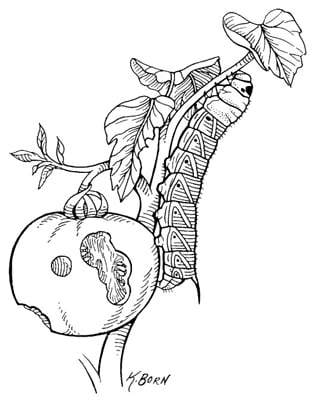 Pick off hornworms and drown them in soapy water.
Pick off hornworms and drown them in soapy water.Tomato fruitworm: This green, 1-inch-long caterpillar with white or yellow stripes feeds on foliage and fruits. They can be handpicked from plants.
Stink bug: These 1/2-inch-long gray or green shield-shaped insects primarily feed on fruits, causing hard, white or yellow spots on the tomato skin. To control stink bugs, keep your garden weed-free.

